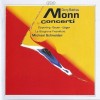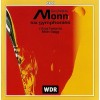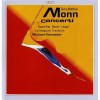Biography
Georg Matthias Monn (born Johann Georg Mann [ref: Reel]) (April 9, 1717, Vienna – October 3, 1750, Vienna) was an Austrian composer, organist and music teacher whose works were fashioned in the transition from the Baroque to Classical period in music.
Together with Georg Christoph Wagenseil and Josef Starzer, Monn formed the Viennese Pre-Classical movement (Wiener Vorklassik in German), whose composers are nowadays mostly known only by their names. However, his successful introduction of the secondary theme in the symphony was an important condition for the First Viennese School that would come some fifty years later.
We know much less about Monn's life than about his musical ideas. Only his appointments as an organist are known, at first in Klosterneuburg near Vienna. Afterwards, he was appointed in the same function in Melk in Lower Austria and at the Karlskirche in Vienna's district Wieden. Monn died from tuberculosis when he was only 33 years old.
Monn's brother Johann Christoph Mann (never Monn, 1726?-82) was also a composer whose works have been confused at times with those of Georg Matthias Monn.[1] The reason for this is that most of Monn's compositions only survive in copies from the 1780s and could therefore also be the works of his younger brother. We still have absolutely no proof that the Johann Georg Mann born in 1717 is the same person as the Georg Matthias Monn who died in 1750. His role as pioneer of the symphony is a scholarly image, coined in the early 20th century, could need some basic musicological reevaluation.
Together with Georg Christoph Wagenseil and other contemporaries such as Leopold Mozart, Monn forms a school of Austrian composers who had thoroughly studied the principles of counterpoint as practised by Johann Sebastian Bach and Johann Joseph Fux, but also forced the change from the Baroque style to the looser, graceful Galante music. Moreover, they renewed the sonata form by expanding the concepts of secondary theme and development. Later on, Michael and Joseph Haydn would develop these concepts to a high point.
The catalog of works written by Matthias Monn contains sixteen symphonies, a score of quartets, sonatas, masses and compositions for violin and keyboard. A harpsichord concerto by Monn was freely transcribed by Arnold Schoenberg into a cello concerto for Pablo Casals. The Monn/Schoenberg cello concerto in D major has been recorded by Yo-Yo Ma and many other cellists. Schoenberg also wrote "continuo realizations" for several works by Monn, including a cello concerto in G minor, which was recorded by Jacqueline Du Pré.







![Het Historische Orgel in Nederland [CD 17 of 20]](http://static.classicalm.com/repository/collection-cover/small/1013-img1343573407457997.jpg)


